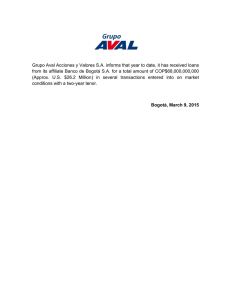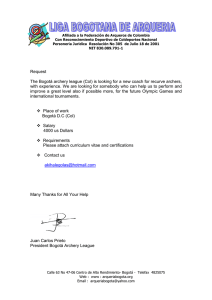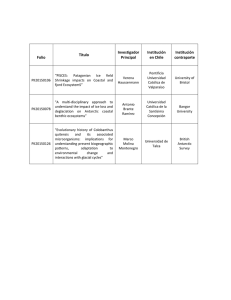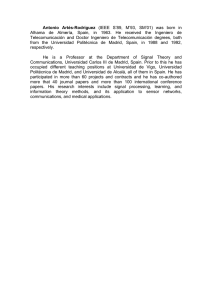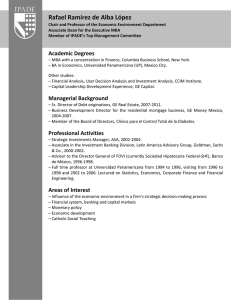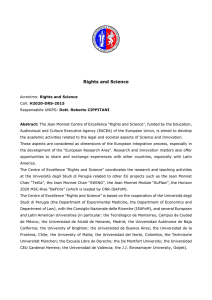Imprimir este artículo - Universidad del Valle
Anuncio
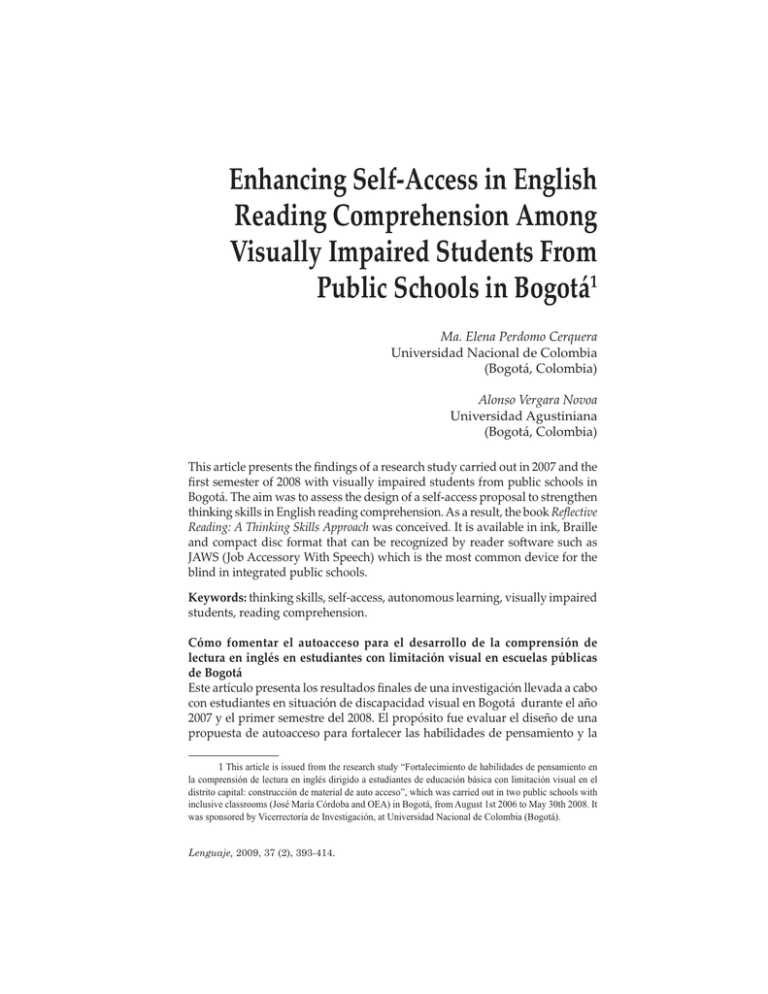
Enhancing Self-Access in English Reading Comprehension Among Visually Impaired Students From Public Schools in Bogotá1 Ma. Elena Perdomo Cerquera Universidad Nacional de Colombia (Bogotá, Colombia) Alonso Vergara Novoa Universidad Agustiniana (Bogotá, Colombia) This article presents the Þndings of a research study carried out in 2007 and the Þrst semester of 2008 with visually impaired students from public schools in Bogotá. The aim was to assess the design of a self-access proposal to strengthen thinking skills in English reading comprehension. As a result, the book Reßective Reading: A Thinking Skills Approach was conceived. It is available in ink, Braille and compact disc format that can be recognized by reader so ware such as JAWS (Job Accessory With Speech) which is the most common device for the blind in integrated public schools. Keywords: thinking skills, self-access, autonomous learning, visually impaired students, reading comprehension. Cómo fomentar el autoacceso para el desarrollo de la comprensión de lectura en ingls en estudiantes con limitación visual en escuelas públicas de Bogotá Este artículo presenta los resultados Þnales de una investigación llevada a cabo con estudiantes en situación de discapacidad visual en Bogotá durante el año 2007 y el primer semestre del 2008. El propósito fue evaluar el diseño de una propuesta de autoacceso para fortalecer las habilidades de pensamiento y la 1 This article is issued from the research study “Fortalecimiento de habilidades de pensamiento en la comprensión de lectura en inglés dirigido a estudiantes de educación básica con limitación visual en el distrito capital: construcción de material de auto acceso”, which was carried out in two public schools with inclusive classrooms (José María Córdoba and OEA) in Bogotá, from August 1st 2006 to May 30th 2008. It was sponsored by Vicerrectoría de Investigación, at Universidad Nacional de Colombia (Bogotá). Lenguaje, 2009, 37 (2)., 393-414. Ma. Elena Perdomo Cerquera - Alonso Vergara Novoa autonomía en la comprensión de lectura en inglés. El producto Þnal fue el libro Reßective Reading: A Thinking Skills Approach que se encuentra impreso en tinta y en Braille y está disponible en formato de disco compacto de manera que puede ser reconocido por un programa lector como JAWS que es el dispositivo para ciegos comúnmente utilizado en los colegios inclusivos distritales. Palabras clave: habilidades de pensamiento, autoacceso, aprendizaje autónomo, limitación visual, comprensión de lectura. Comment encourager le libre accès à la comprhension de lecture en anglais pour des lèves sou rant de dÞciences visuelles dans les coles publiques de Bogotá Cet article présente les résultats d’une recherche réalisée avec des étudiants malvoyants à Bogota en 2007 et au cours du premier semestre de 2008. L’objectif était d’évaluer la conception d’une proposition d’auto-accès pour renforcer la capacité de réßexion et l’autonomie dans la compréhension de lecture en anglais. Suite à ce!e recherche, le manuel Reßective Reading: A Thinking Skills Approach a été créé. Celui-ci se trouve imprimé sur papier et en Braille, et il est aussi disponible en CD qu’on peut lire avec un logiciel tel que JAWS. Mots cls : habiletés de réßexion, apprentissage autonome, étudiants malvoyants, déÞciences visuelles, compréhension de lecture. introduction One of the greatest challenges in Colombia regarding education in recent decades has been to implement policies to foster the insertion and permanence of the impaired population in inclusive classrooms. Developing awareness among the society has been a hard process, taking into account that it has implied changing the traditional conceptions and a!itudes of people. Unesco (2009) states that apart from being conscious of the learners` needs it is necessary to guarantee a commonly accepted level of quality education for everyone: an inclusive education. Based on the acknowledgement of diversity and multiculturality, the Secretary of Education of Bogotá through the “Plan Sectorial de Educación. Bogotá una Gran Escuela” (2004), has made great e"orts to make it happen with the support of specialized advisers and technological aids. However, in public schools, visually impaired students are at a disadvantage to their sighted partners, one of the main reasons being 394 Universidad del Valle Enhancing Self-Access in English Reading Comprehension Among Visually Impaired Students ... the lack of appropriate materials for their own needs. As a consequence, blind and low vision learners tend to depend a lot on other people to perform school activities, a"ecting their own autonomy development and restricting the opportunities to strengthen cognitive skills and heuristic learning. In order to contribute to solving this problem, an elementary reading comprehension book for English was designed keeping in mind that learning a foreign language is one of the most di#cult tasks for visually impaired learners. Transcribing texts and exercises into Braille or using reader programs is not enough to facilitate the process. The pedagogical proposal is based on the integration of the thinking skills model designed by Marzano (1992) and the self-access scheme developed by Sheerin (1989). However, it was necessary to modify the original frameworks to fulÞll the needs of the visually impaired learners. This basic material may help to support English learning projects like Bogotá and Colombia Bilingüe. theoretical framework Three basic constructs support this proposal: the importance of autonomy and self-access materials in language learning, developing thinking skills as a resource to strengthen reasoning and the reading process in visually handicapped students. Holec (1981), cited by Sinclair (2000), deÞnes autonomy as the capacity of taking control of one’s own learning. Its main purpose is to reÞne the self-regulation process which implies being able to plan, monitor and evaluate the cognitive activities by means of metacognition, that is understood, following Benson (2001), as the ability to reßect critically on one’s own learning processes. It is important to highlight that autonomy does not occur spontaneously. It is a process in which intrinsic motivation gradually increases, and the decision making capacity improves every time. The role that teachers play is fundamental; they need to be skillful when assigning tasks and implementing cognitive and metacognitive strategies in order to favor the progressive transfer of responsibility to students, as Monereo et al. (2001) and Insuasty (1999) state. Lenguaje, 2009, 37 (2). 395 Ma. Elena Perdomo Cerquera - Alonso Vergara Novoa One of the best pedagogical tools of autonomous learning is selfaccess material. According to Sheerin (1989), it is aimed at encouraging students to learn independently by facilitating self-assessment and correction. However, self-access does not imply absolute independence from teachers and classmates; this must be used to raise the level of autonomy and to foster learning outside the classroom with the tutorship and support of the teacher according to the students’ requirements. There are some special conditions to design self-access materials. For example, they must help learners recognize that they have the skills to perform some tasks for themselves (Sturtridge, 1992). The materials also must be motivating, easy to understand and need to include immediate feedback to facilitate assessment. Kit and Bahasa (2002) suggest some other speciÞc features like clear aims, a direct and simple writing style, and an accessible format to avoid boredom among the users. Another theoretical basis has to do with the thinking skills development. Beas, Santa Cruz, Thomsen and Utreras (2005) deÞne them as skills that are needed to analyze concepts critically and to establish connections between academic knowledge and daily life. Such skills are inherent to human beings, but they may be reÞned. That is the reason why Tishman, Perkins and Jay (2006) as well as Rosero (2002) stress the importance of developing skills within an environment in which they are supported and valued. Their conscious practice stimulates critical, creative and practical reasoning according to Sternberg and Spear-Swerling (1996). Based on Marzano’s typology (1992), the following thinking skills were chosen for the book: • Comparing: it allows the identiÞcation of similarities and di"erences between two or more people, animals, ideas or objects. • Classifying: it consists of organizing objects, animals, events or ideas into groups that share common characteristics. • Problem Solving: it is a useful skill for Þnding solutions to di#culties or limitations that may come up when trying to achieve a goal. It is very useful to identify the cause of the problem. • Decision Making: it aims at selecting the best choice among a variety of possibilities. Determining some criteria is essential to evaluate the options and make the selection process easier. 396 Universidad del Valle Enhancing Self-Access in English Reading Comprehension Among Visually Impaired Students ... • Abstracting: it is a skill that allows recognition of the most relevant information from a situation in order to establish a general pa!ern that may be extended to other contexts. A general pa!ern or an abstract idea may be expressed by means of a universally valid statement. • Analyzing Perspectives: this skill is necessary to recognize the di"erent points of view regarding a controversial issue and the reasons that support them, so that a position can eventually be assumed. • Constructing Support: it is a thinking process oriented to elaborate logical arguments and find proof to support a statement. Mere opinions, beliefs or perceptions may lead to false generalizations, then facts, testimonies and veritable data are of paramount importance to construct support. The practice of the skill is helpful to learn how to select and organize the available information and transform it into evidence. Reading comprehension in subjects with visual impairment was also an essential topic for the framework. Research has demonstrated that blind individuals learn to read very slowly. The Braille system is the means to achieve that goal but its young users o en lack skills such as discrimination of le!ers and the correct use of meaningful vocabulary which are necessary to carry out a good reading process. For this reason, it is highly recommended to begin the transition from oral language to wri!en language from an early age, focusing on links between sounds, le!ers and the experiences of daily life (Miller & Rash, 2001). Once the readers are familiar with the Braille system, the reading speed can vary according to their ability to move the Þngers and make inferences (Huertas & Simon, 1994). However, learning to decode is not the only problem blind people have to deal with. When blindness is congenital, understanding and interpreting texts is a complex task because as Guido (2000) expresses, it takes too much e"ort to recognize terms related to color, shape or size. They need to practice manual-tactile-acoustic exercises to be able to identify objects. Apart from Braille, blind people also have other instruments to approach wri!en information as for example the assisted technology Lenguaje, 2009, 37 (2). 397 Ma. Elena Perdomo Cerquera - Alonso Vergara Novoa (AT) that applies screen readers and screen magniÞers to recognize and process speech. There is a great variety of them, which includes self-voicing applications like HAL, Zoomtext with Speech or Window Eyes, and webbased screen readers like Spoken-Web or BrowseAloud. However, in public schools, the most accessible so ware is JAWS (Job Accessory With Speech) which is a reader that verbalizes the texts shown on the computer screen (Andrade, 2003). It is also an excellent resource for improving listening and pronunciation in English or any other foreign language, since di"erent linguistic variations and accents can be distinguished. Therefore, JAWS is a very useful pedagogical resource in school contexts. pedagogical design In most cases thinking skills are used intuitively and people do not make the most of them. The advantage of following a model such as the one proposed here is that convergent and divergent thinking are greatly activated. When carrying out sequential or algoritmic activities to solve problems, logical-analytical reasoning is implemented; this is one of the main functions that convergent thinking appeals to in order to make decisions. Besides, there are some tasks in the book that require creative problem solving, and stimulate divergent thinking due to the fact that students should produce original ideas and innovative solutions (Romero, Rodríguez & Ramírez, 2003). In terms of content, the book Reßective Reading: A Thinking Skills Approach was designed based on Marzano’s proposal (1992) which implies the explicit teaching of thinking skills following a step by step procedure and using graphic organizers like concepts maps, charts or diagrams. As visual aids, they do not work for blind people; therefore it was necessary to adapt such a proposal. Instead of graphic representations, systematic descriptions were suggested. Another important change is that the procedures include everyday student problems and the solutions require consistent justiÞcations (Appendix 1) unlike Marzano’s conception. The book is made up of seven (7) units. Each of them contains a story wri!en by a child whose mother tongue is English, some language descriptions, a thinking skill procedure, vocabulary from the story and activities to reinforce learning. It also has an answer key section and a self-assessment questionnaire to encourage reßection. 398 Universidad del Valle Enhancing Self-Access in English Reading Comprehension Among Visually Impaired Students ... At the beginning of the project, Sheerin’s self-access scheme (1989) was adopted; however, it was necessary to redesign the units taking into account the students’ limitations noticed during the piloting process. In order to make self-access easier, and bearing in mind that students showed a low level of proÞciency in the English language, some of the information was wri!en in Spanish, but the readings and the activities were in the foreign language, so English is necessarily practised and consolidated. methodological frame Action research was considered as the most appropriate methodology for carrying out this project. According to Elliot (1993) and Olson (1991), the aim of the approach is to improve the pedagogical practice in terms of processes and results. It also allows teachers to undertake innovative proposals by means of a continous ethical reßection. Therefore, they can go beyond the limits of their context and contribute to the construction of educational policies. A!ending to the particular features of this research, the model proposed by Johnson (2005) was adapted as follows: The Þrst stage was contextualization in which a register of the population under study was established and their thinking skills command was diagnosed. In the planning stage the seven didactic units were elaborated. During the implementation stage two units in Braille were piloted in order to identify the strengths and weaknesses of the design: the unit Comparing was implemented once and the other, Classifying, twice because the Þrst time some problems were detected, therefore it was necessary to correct them and pilot the unit again. Then, the data discussion and analysis was carried out and a Þnal report was made. Description of the target population There are 11 public schools for blind and low vision students in Bogotá. Those learners are supported by some experts known as tißologists, who are in charge of adapting materials and contributing to making the learning process a successful experience. Lenguaje, 2009, 37 (2). 399 Ma. Elena Perdomo Cerquera - Alonso Vergara Novoa Table 1. Visually Impaired Students in Primary Schools (2008) No Zone 1 Bosa 2 3 4 5 6 7 8 Kennedy Usme Suba Tunjuelito Tunjuelito San Cristobal Fontibón 9 Ciudad Bolivar 10 11 Engativa Usaquén School Carlos Albán Holguín OEA Gran Yomasa Gerardo Paredes José RuÞno Cuervo José María Córdoba José Felix Restrepo Luis Ángel Arango Rodrigo Lara Bonilla República de China Aquileo Parra Total Blind Students Low Vision Students 6 2 6 2 1 5 4 0 3 7 5 8 1 8 2 1 3 1 7 2 39 3 0 38 Table 2. Visually Impaired Students in Secondary Schools (2008) Blind Students Low Vision Students 3 1 8 0 6 3 3 2 José RuÞno Cuervo 3 1 José María Córdoba 8 3 San Cristobal * José Felix Restrepo 7 9 8 Fontibón Luis Ángel Arango 4 2 9 Ciudad Bolivar 1 2 10 Engativa 3 3 11 Usaquén 2 42 1 33 No Zone 1 Bosa 2 3 Kennedy Usme 4 Suba 5 Tunjuelito 6 Tunjuelito 7 School Carlos Albán Holguín OEA Gran Yomasa Gerardo Paredes Rodrigo Lara Bonilla República de China Aquileo Parra Total * Evening classes: 18 adults. 400 Universidad del Valle Enhancing Self-Access in English Reading Comprehension Among Visually Impaired Students ... Most of the interviewees hardly ever practiced English out of the classroom, partly because it is di#cult to Þnd information adapted to Braille or any other similar resource. During this research it was found that there were 170 visually impaired students in the inclusive schools distributed as shown in Tables 1 and 2. The piloting was carried out during February and March 2008 with 15 students from 9th, 10th and 11th grades in two public schools: José María Córdoba and OEA. Data collection instruments During the contextualization a needs analysis was applied to get academic and personal information from the students and a diagnostic test was implemented to assess how well they used the thinking skills.There were three kinds of instruments to gather data in the piloting stage: a students’ questionnaire, a researcher’s questionnaire and an external observer’s questionnaire, all of them intended to determine whether the material design had the appropriate characteristics to make self-access easier for visually impaired students. Finally, a self-assessment instrument was also applied in order to promote metacognitive and self-regulation experiences. Data analysis To identify how visually disadvantaged students employed thinking skills, it was decided to evaluate their argumentative competence by means of a diagnostic test. Argumentation consists of supporting a decision or a point of view with logical reasons, and it implies the use of di"erent cognitive skills such as comparing, abstracting and constructing support, among others. The diagnosis showed a very rudimentary use of thinking skills. Students justiÞed their answers by appealing to tautological arguments or paraphrasing information already contained in the instrument, without any convincing evidence. On this respect, Beas et al. (2005) point out that there is a general tendency among learners to avoid analysis and as a result, sophisms and poor explanations are recurrent. Based on such primary analysis, the book to be designed required strategies and exercises showing how to support ideas and how to take Lenguaje, 2009, 37 (2). 401 Ma. Elena Perdomo Cerquera - Alonso Vergara Novoa advantage of the thinking skills procedures, all this, in order to make the transition from intuitive knowledge to structured knowledge, by means of interpretation, analysis and assessment–which are characteristics of critical thinking (Fisher, 2007). results In order to study the feasibility of the self-access proposal, the data were grouped into two categories: content receptivity and autonomous a itudes. These were established from the types of content that must be promoted in the classroom according to Coll, Pozo, Sarabia, and Valls (1992), as well as Pozo and Monereo (1999). Content receptivity Conceptual and procedural contents were analyzed in this category. The Þrst one, also called declarative is made of concepts, categories, principles and data (Díaz & Hernández, 2004). In the Þrst design of the book, all the conceptual information was displayed in a section called preparation, following the Sheerin’s self-access format (1989). It contained the thinking skill procedure and explanations about grammar and vocabulary. During the Þrst session at José María Córdoba School where the unit about classifying was tested, the students asked many questions. The observations and the subsequent results suggested that there was too much information for the sightless learners to recall when developing the tasks. The session lasted about 180 minutes, twice the expected time. The researcher wrote in his instrument: Los estudiantes entendieron las explicaciones de la sección de preparación pero parecen haber olvidado lo leído al momento de realizar el procedimiento (Researcher, J. M. Córdoba School. Unit classifying). For this reason, the structure of the seven units was changed. So, the conceptual information was divided into small sections, each one of them with its application exercise. A key factor that a"ected the performance of the pupils during the piloting of the units had to do with the fact that some of them were 402 Universidad del Valle Enhancing Self-Access in English Reading Comprehension Among Visually Impaired Students ... in a process of transition from low vision to total blindness and had a poor command of the Braille system. They read le!er by le!er in order to understand each word and as a consequence, they were prone to missing the global text. Another obstacle was that students found it di#cult to remember some vocabulary when doing completion activities. That is why the exercise was simpliÞed and a selection activity was chosen instead, as follows: First version Complete the deÞnition of “recycling” by using the following words: create, process, products, residual. Recycling is the of using materials to new . Final version Select the appropriate words to deÞne “Recycling” Recycling is the (process / manner) of using (residual / big) materials to create (old / new) products. A problem also noticed during the observations had to do with the low proÞciency in the foreign language. The participants had troubles understanding the story included in the unit. Owing to this the text was simpliÞed in terms of vocabulary and grammar, but always maintaining the essence and the contents that the writers wanted to express originally (Appendix 2). In relation to the procedural content or know-how, Valls (1993) mentioned by Monereo et al. (2001) deÞnes it as the set of actions that the pupils should learn to carry out in order to solve a task. In the designed material, such content corresponds to the thinking skills procedures. As said before, these were adapted and exempliÞed so that they were more practical for visually impaired learners. The appropriateness of such adaptation was assessed and the results were positive as the next comments show: Aprendí el procedimiento con el ejemplo (Yeimmy, OEA School. Unit Classifying). Los procedimientos mostraban paso a paso cómo realizar el ejercicio (Marcela, J. M. Córdoba School. Unit Comparing). Lenguaje, 2009, 37 (2). 403 Ma. Elena Perdomo Cerquera - Alonso Vergara Novoa Supe cómo hacer el procedimiento por la explicación paso a paso de la habilidad de la comparación (Camilo, OEA School. Unit Comparing). The researcher said: El ejemplo no les pareció difícil de asimilar, al contrario, por sus comentarios, éste dio mayor claridad al procedimiento descrito anteriormente en la unidad (Researcher, J. M. Córdoba School. Unit Comparing). Autonomous a!itudes It was necessary to determine whether the self-access design actually generated some signs of independence, motivation and reßection among the students because these a!itudes are essential in order to achieve meaningful and autonomous learning. A!itudes are deÞned as subjective (cognitive-a"ective) experiences that may be expressed verbally or nonverbally and entail value judgments (Díaz & Hernández, 2004). A er piloting the redesign of the units, it was noticed that the activities were solved with more independence, learners asked fewer questions in comparison with the Þrst session and wasted less time. In regard to this, they commented: Con la explicación dada en la unidad, no tuve necesidad de preguntar a otra persona. (Marcela, J.M. Córdoba School. Unit Comparing) La unidad tiene todas las pautas claras para resolver los ejercicios. (Juan Alejandro, OEA School. Unit Classifying) Sturtridge (1992) states that self-access resources must give students the option to guide their learning and to be able to work at their own pace. The level of autonomy varies depending on the previous knowledge and the development of cognitive skills such as inference or abstraction. Therefore, the aim was to elaborate material with strategies to make learning independence possible. Besides independence, the material seemed to raise motivation or interest in learning the foreign language among the students: 404 Universidad del Valle Enhancing Self-Access in English Reading Comprehension Among Visually Impaired Students ... Se me hace difícil entender y poner atención por mi problema de visión, pero con este material puedo aprender por mi cuenta. (Marcela, J. M. Córdoba School. Unit Comparing). Tenía contenidos nuevos para mí que me hacen interesarme más por el inglés (Jaime, OEA School. Unit Classifying). Me gustó el taller y me gustaría aprender más (Ingrid, J. M. Córdoba. School. Unit Classifying). According to Muñoz (2000), motivation in language learning can be classiÞed in four types: instrumental, integrative, extrinsic and intrinsic. The Þrst one is related to pragmatic interests, the second is associated to social and cultural interests, the third originates from external sources, and the last one is the result of personal or internal interests. Most of the students’ remarks in the present analysis Þ!ed in the extrinsic motivation category; Ingrid, Jaime and Marcela are good examples. Only two students were more oriented to instrumental motivation since they highlighted the importance of English in daily life. The observer commented: Los alumnos resolvieron las actividades con agrado. El interés fue evidente (External Observer, OEA School. Unit Comparing). Self-access tools must be motivating for the learner. Without this element, they simply do not work. Besides, students need to experience a certain degree of autonomy and competence to do the tasks, essential conditions to generate intrinsic motivation (Díaz & Hernández, 2004; Brown & Rogers, 2002). In an a!empt to help the students analyze their learning processes and products critically, a self-assessment questionnaire was proposed (Appendix 4). It was crucial to determine the validity of such instrument, so the students’ reßections were examined. They talked about the thinking skills in the following terms: Siempre hay que seguir unos pasos predeterminados para poder formar los grupos (Juan Alejandro, OEA School. Unit Classifying). Lenguaje, 2009, 37 (2). 405 Ma. Elena Perdomo Cerquera - Alonso Vergara Novoa Para clasiÞcar se deben formar grupos, de la misma clase (Jaime, OEA School. Unit Classifying). They were also able to predict situations in which thinking skills might be applied. Some of them linked them to the curriculum subjects, like Jaime and Eduardo: En la materia de matemáticas y algunos problemas de estadística (Jaime, OEA School. Unit Classifying). . En la materia de matemáticas especíÞcamente en el tema de ecuaciones (Eduardo, OEA School. Unit Classifying). Some others, such as Daniel and Camilo, considered the possibility of transferring the new knowledge to daily life: En una actividad cotidiana (Daniel, J. M. Córdoba School. Unit Comparing) En mi vida personal (Camilo, OEA School. Unit Classifying). Concerning the resources the participants utilized to solve the di#culties when developing the activities, they a#rmed that the book itself had provided them with strategies and suggestions to go through. Based on the information above, it can be said that the selfassessment instrument was functional to generate some reflection among the students. However, constant analysis is required to build up a systematic self-regulation empowerment which is one of the most important devices in achieving meaningful learning. Soto (2003) mentions three levels in learning: in the Þrst one, learners process the information, in the second one, they are able to evaluate the processing and, in the last one, learners can make decisions regarding knowledge. Self-assessment is a particularly useful tool in the second level and its e"ects are noticeable in the third one when information is successfully transferred to other situations. 406 Universidad del Valle Enhancing Self-Access in English Reading Comprehension Among Visually Impaired Students ... conclusions Reading comprehension in English is a very complex activity for visually impaired learners because they have di#culties in Þguring out concepts related to color, volume, or shape. In many cases the command of the Braille code and the English language is quite poor. Consequently, they need to read many times and require constant support to process the information. Those limitations make blind and low vision students much more dependent than the sighted ones; however, it is possible to encourage autonomy as long as the pedagogical materials have clear and accurate guidelines, contents and feedback. These factors contribute to raising self-esteem, motivation and reßection. In addition, self assessment is highly recommended to reinforce independence because it helps learners to be more aware of what and how they are learning, which according to Soto (2003), modiÞes a!itudes related to knowledge. It is also possible to teach thinking skills explicitly to blind people as long as the procedures are based on descriptive and systematic representations of mental processes such as grouping, selecting or inferring. Although the book has been thought of as a self-access resource it can be used within regular English classes as complementary material and the procedures might be adapted to other curriculum areas since its content is suitable for any context where thinking skills are intended to be promoted at an elementary level. references Alcaldía Mayor de Bogotá, D.C. Secretaría de Educación (2004). Integración de escolares con deÞciencia cognitiva y autismo: Ingreso, evaluación y promoción. Bogotá: Secretaría de Educación. Andrade, P. (2003). Modulo de estrategias para la enseñanza del inglés en el marco de la atención educativa a población con limitación visual. Bogotá: INCI. Beas, J., Santa Cruz, J., Thomsen, P. & Utreras, S. (2005). Enseñar a pensar para escribir mejor. México: Universidad Católica de Chile. Benson, P. (2001). Teaching and researching autonomy in language learning. Essex: Pearson Education. Brown, J. D. & Rogers, T. (2002). Doing second language research. Oxford: Oxford University. Lenguaje, 2009, 37 (2). 407 Ma. Elena Perdomo Cerquera - Alonso Vergara Novoa Coll, C., Pozo, J. I., Sarabia, B. & Valls, E. (1992). Los contenidos en la Reforma: Enseñanza y aprendizaje de conceptos, procedimientos y actitudes. Madrid: Santillana. Díaz F. & Hernández, G. (2004). Estrategias docentes para un aprendizaje signiÞcativo. México: McGraw-Hill. Elliot, J. (1993). Action Research for educational change. Bristol: Open University. Fisher, A. (2007). Critical Thinking: An Introduction. Cambridge: Cambridge. Guido, S. (2000). La comunicación y el lenguaje en personas con necesidades educativas especiales. In N. de Salazar, S. Guido, S. Lara, L. Obando. & I. Toro, Comunicación aumentativa y alternativa (pp. 67-93). Bogotá: Arfo. Holec, H. (1981). Autonomy and Foreign Language Learning. Oxford: Pergamon. Huertas, J. A. & Simón, C. (1994). SigniÞcado y sentido de la lectura Braille desde un punto de vista social y psicológico. Retrieved October 15, 2009, from Integración 19 Web site: h!p://innova.decp.uam.es/publi/descarga. php?UID=&id=9811&profesor=97. Insuasty, L. D. (1999). Generación y uso del conocimiento desde la acción del docente y la respuesta del aprendiente. Guía del aprendizaje autónomo “C”. Bogotá: UNAD-CAFAM. Johnson, A. (2005). A short guide to action research. Boston: Pearson Education. Kit, L. & Bahasa, J. (2002). Designing self-access materials for ESP. Retrieved October 15, 2009, from Journal Pendidikan available in h!p://apps.emoe.gov.my/ ipba/rdipba/cd1/ article63. Marzano, R. (1992). A di!erent kind of classroom. Alexandría: Association for Supervision and Curriculum Development. Miller, C. & Rash, A. (2001). Lectura para todos: Ampliar las opciones de Alfabetización. Retrieved May 2, 2008, from See/hear newsle er available in h!p://www.discapnet.es/documentos/Tecnica/Interedvisual/ponencias/ ingles_invidentes_haa.pdf. Monereo, C. (Coord.) et al. (2001). Ser estratégico y autónomo aprendiendo. Unidades didácticas de enseñanza estratégica para la ESO. Barcelona: Graó. Muñoz, C. (Ed.) (2000). Segundas lenguas. Barcelona: Ariel. Olson, M. W. (Comp.) (1991). La investigación-acción entra al aula. Argentina: Aique. Pozo, J. I. & Monereo, C. (Coord.) (1999). El aprendizaje estratégico. Enseñar a aprender desde el currículo. Madrid: Aula XXI, Santillana. Rosero, B. (2002, January/June). Actitudes y percepciones positivas frente al conocimiento procedimental. Experiencias de Mediación Cognitiva, 2 (2), 57-79. Romero, P., Rodríguez, G. & Ramírez, J. (2003). Pensamiento hábil y creativo. Herramientas pedagógicas para desarrollar procesos de pensamiento. Bogotá: Redipace. 408 Universidad del Valle Enhancing Self-Access in English Reading Comprehension Among Visually Impaired Students ... Ruiz, O. L. (2003). Orientaciones generales para la enseñanza del sistema de lectoescritura Braille. Bogotá: INCI. Sheerin, S. (1989). Self–Access. Oxford: Oxford University. Sinclair, B. (2000). Learner autonomy: The next phase?. In B. Sinclair., I. McGrath. & T. Lamb (Eds.), Learner autonomy. Teacher autonomy: Future directions (pp. 4-14). Birmingham: Longman in association with the British Council. Soto, C. A. (2003). Metacognición: Cambio conceptual y enseñanza de las ciencias. Bogotá: Magisterio. Sternberg, R. & Spear-Swerling, L. (1996). Enseñar a pensar. Madrid: Aula XXI Santillana. Sturtridge, G. (1992). Self-access. Preparation and training. Manchester: The British Council. Tishman, S., Perkins, D. & Jay, E. (2006). Un aula para pensar. Aprender y enseñar en una cultura de pensamiento. Buenos Aires: AIQUE. UNESCO. (2009). Policy guidelines on inclusion in education. Retrieved October 12, 2009 from h!p://unesdoc.unesco.org/images/0017/001778/177849e.pdf. Valls, E. (1993). Los procedimientos: aprendizaje, enseñanza y evaluación. Barcelona: ICE/Horsori. about the authors María Elena Perdomo Cerquera M.A in TESOL, London University. Full-time Associate Professor at the Universidad Nacional de Colombia. Leader of the research group “Pedagogía de la autonomía y desarrollo del pensamiento”. Head of two research projects related to thinking skills, reading comprehension, autonomy, materials design, collaborative group, metacognition and values in education. E-mail: [email protected] Alonso Vergara Novoa B.A. in Philology and Languages from Universidad Nacional de Colombia. Full-time teacher at Universitaria Agustiniana. Currently carrying out his Masters’ Studies in Education at the PontiÞcia Universidad Javeriana. Member of the research group “Pedagogía de la autonomía y desarrollo del pensamiento” and co-researcher in the projects developed within the group. E-mail: [email protected] Fecha de recepción: 10-08-2009 Fecha de aceptación: 20-10-2009 Lenguaje, 2009, 37 (2). 409 Ma. Elena Perdomo Cerquera - Alonso Vergara Novoa Appendix 1 Sample of a Unit UNIT 1 LEARNING TO COMPARE ¿CÓMO COMPARAR? Todas las personas tienen la capacidad de comparar de forma intuitiva, sin embargo, aprender a hacer comparaciones sistemáticas es de gran utilidad para tomar decisiones apropiadas. Comparar es una habilidad que permite identiÞcar semejanzas y diferencias entre dos o más personas, animales, ideas u objetos. Los pasos para llevar a cabo este proceso se enuncian a continuación: 1. Se identiÞca un caso o problema en el que sea necesario comparar. 2. Se selecciona las opciones a comparar. 3. Se identiÞcan las semejanzas y las diferencias. 4. Se escribe una conclusión con base en las semejanzas y diferencias. 1. Lo anterior se ilustra con el siguiente ejemplo: Caso. David quiere una mascota. Los animales que preÞere son los perros y los loros. 2. Opciones a comparar. Un perro y un loro. 3. Semejanzas y diferencias. Estas se identiÞcan teniendo en cuenta el objetivo de David, el cual es escoger una mascota. Semejanzas a. El perro y el loro son animales sociables. b. El perro y el loro pueden ser adiestrados. Diferencias a. El loro puede vivir más años que el perro. b. El perro protege el hogar mientras que el loro no puede. c. La comida del perro es costosa mientras que la del loro no. 4. Conclusión Aunque el loro y el perro son animales sociables, este último es un buen guardián. Sin embargo, su sostenimiento es costoso. Por otro lado, el loro tiene una vida más larga. Por lo tanto, si no hay restricciones de dinero y resulta útil que la mascota cuide la casa es más apropiado un perro, pero si se quiere una mascota que demande menos cuidados, el loro puede ser una mejor opción. 410 Universidad del Valle Enhancing Self-Access in English Reading Comprehension Among Visually Impaired Students ... LECTURA El siguiente vocabulario puede ser de gran utilidad para facilitar la comprensión del texto “Anita and Me”. Best: Buggy: CornÞelds: Horse: However: Mennonites: Snow: Summer: Winter: Mejor Coche tirado por caballos Campos de maíz Caballo Sin embargo Grupo religioso conocido como antigua orden de los menonitas Nieve Verano Invierno Lea la historia cuidadosamente y resuelva la actividad 2. ANITA AND ME (Adapted Version) Anita is my best friend. Our houses have cornÞelds. Anita and I have many di erences. She and her family practice the Mennonites’ religion. They do not have a car but they have a horse and a buggy. They do not have a radio or a TV. However, we have many similarities. We both have big families and we play the same games. In winter we play in the snow and in summer we swim. Anita is nice and special. That is why she is my best friend ACTIVITY A partir de la lectura “Anita and me”, aplique el procedimiento de la comparación en inglés. Los primeros dos pasos están resueltos. 1. Case. Anita and Maria have some di erences, but they are good friends. 2. Options to compare. Anita and Maria 3. Similarities and di erences. Escriba una S si las oraciones expresan semejanzas o una D si expresan diferencias. a. Both Anita and Maria have cornÞelds. b. Both Anita and Maria play games. Lenguaje, 2009, 37 (2). 411 Ma. Elena Perdomo Cerquera - Alonso Vergara Novoa c. Maria has a car whereas Anita has a buggy. d. Anita is a Mennonite whereas Maria is not. 4. Conclusión. Con base en la lectura “Anita and me” y el procedimiento aplicado, marque con una X la conclusión más apropiada. a. Anita and Maria are good friends because they have big families, swim and play games together. b. Anita and Maria are good friends because they have cornÞelds and a car. 412 Universidad del Valle Enhancing Self-Access in English Reading Comprehension Among Visually Impaired Students ... Appendix 2 Original Version of the Story “Anita and Me” Anita and me Anita is my best friend. She lives next door to me on a farm. Our houses have cornÞelds all around them. Anita’s family belongs to a group called Old Order Mennonites. Anita and I have many di erences. She only wears dresses. She always wears her hair in braids. I wear pants and a shirt most days and dresses on Sunday. I wear my hair in braids sometimes, but I usually wear it down. Anita and her family don’t have a car. They have a horse and a buggy. They don’t have radio, TV or VCR. Anita speaks Pennsylvania Dutch and English. She goes to a di erent school than I do, a one-room schoolhouse with an outhouse. But even so, we’re still friends. There are a lot of things about us that are the same. We both have big families, and we all play together. In the fall we rake up leaves and then jump into the piles. We also check the apple trees to see if the apples are ripe. In winter we play in the snow. We also exchange Christmas gi!s. In the spring, we play games like Hide-and-Seek, Adam and Eve, Lemonade, Grandma’s Big Fat Toe, and Mother, May I?. In the summer we swim, and sometimes we camp out and catch lightning bugs. My family invites Anita and her family over for birthday parties, and they invite us, too. Anita is nice and special; See why she’s my best friend? Original version: SOUTHERTON, Maria. Age 9. Adapted from: HIGHLIGHTS FOR CHILDREN. May, 1997. Vol 52, No 5; p34. Lenguaje, 2009, 37 (2). 413 Ma. Elena Perdomo Cerquera - Alonso Vergara Novoa Appendix 3 Self-Assessment Instrument * SELF-ASSESSMENT 1. What new information did you learn about the thinking skill of comparing? 2. 3. Why is it important to compare? 4. 5. How did you solve the di"culties while developing the activities of the unit? 6. * The instrument was originally wri#en in Spanish. 414 Universidad del Valle
